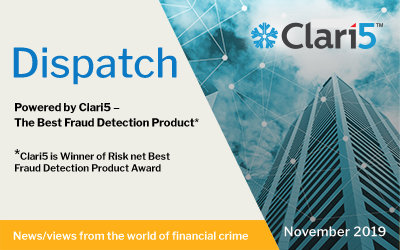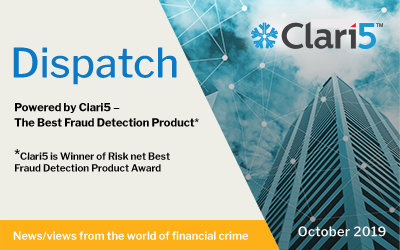 Clari5 has been featured once again in the Fintech Global RegTech 100 – a list of 100 of the world’s most innovative RegTech companies that financial institutions need to know about as they develop their RegTech strategies. The selection criteria included key factors such as impact on the problem being solved; growth in terms of capital raised, revenue, customer traction; innovation of technology solution offered; potential cost savings, efficiency improvement and revenue enhancements generated for clients; and how important is it for a financial institution to know about the company. Read More
Clari5 has been featured once again in the Fintech Global RegTech 100 – a list of 100 of the world’s most innovative RegTech companies that financial institutions need to know about as they develop their RegTech strategies. The selection criteria included key factors such as impact on the problem being solved; growth in terms of capital raised, revenue, customer traction; innovation of technology solution offered; potential cost savings, efficiency improvement and revenue enhancements generated for clients; and how important is it for a financial institution to know about the company. Read More
Author: Clari5
Vijaya Bank (now Bank of Baroda) and Clari5 Win IBS Intelligence Global FinTech Innovation Award 2019 for Most Innovative Use of AI & Machine Learning
 Vijaya Bank (now Bank of Baroda) and Clari5 have won the award for Most Innovative Use of AI & Machine Learning at the 1st IBS Intelligence Global FinTech Innovation Awards. For over 28 years IBS Intelligence has been a leader in global banking technology research and this year they decided for the first time to organize an awards ceremony. The 1st IBS Intelligence Global FinTech Innovation Award had 26 winners and 22 runners-up from banks and suppliers across 15 countries. The competition was fierce with about 150 participants. Nominations were carefully assessed on the basis of key factors such as Program Complexity, Program Governance, Best Practices & Tools Adopted, Originality & Simplicity, Adaptability of Concept, Innovation Excellence and Customer Impact before deciding the winners. Read More
Vijaya Bank (now Bank of Baroda) and Clari5 have won the award for Most Innovative Use of AI & Machine Learning at the 1st IBS Intelligence Global FinTech Innovation Awards. For over 28 years IBS Intelligence has been a leader in global banking technology research and this year they decided for the first time to organize an awards ceremony. The 1st IBS Intelligence Global FinTech Innovation Award had 26 winners and 22 runners-up from banks and suppliers across 15 countries. The competition was fierce with about 150 participants. Nominations were carefully assessed on the basis of key factors such as Program Complexity, Program Governance, Best Practices & Tools Adopted, Originality & Simplicity, Adaptability of Concept, Innovation Excellence and Customer Impact before deciding the winners. Read More
Is Open Banking More Open to Fraud?

Open banking (under the European Union’s Revised Payment Services Directive or PSD2), means third parties can link up to customers’ accounts, provided the customer consents. With data-sharing as the central feature, open banking is designed to encourage higher product and service innovation, make it easier for non-banks to participate and streamline user experience.
With open banking, the volume and value of transactions have grown exponentially. With more banks across the globe getting ready to open their doors to third parties to access their customer data, open banking is also expected to bring in a new era of fraud. So the new legislations intended to democratize banking and provide a better deal for customers has also necessitated increased and smarter vigilance.
According to KPMG’s latest Global Banking Fraud Survey, open banking is considered a significant challenge in fraud risk by banks. Questions are being raised on the reliance that can be placed on third party controls. Open banking also presents an opportunity to gain a richer customer dataset, which can be used to prevent and detect fraudulent activity and recover fraud losses.
Among some of the emerging threats are copycat websites pretending to be third-party providers, scammers hacking into a third party to gain access to information held in current account statements are scammers posing as a third party in correspondence to extort information. This then allows fraudsters to access customers’ money fraudulently. In more complex scams, information, e.g. which service provider the customer has a utility contract with, could be used to extract money.
One fundamental challenge banks face is the absence of a single source of ID verifiable data to use. For instance, they require access to different streams of data for KYC compliance. This makes it essential to have access to the most up-to-date and relevant data from billions of global contact records. The data should be from trusted sources such as credit agencies, government agencies, utility companies, and international watchlists.
If data is not obtained from trusted sources, banks might end up with incomplete reference data sets that could have errors and this in turn puts a question on the reliability of the data for fraud prevention.
While sourcing data for ID verification, it is also crucial that it improves on existing customer data, to gain a 360-degree customer view to aid the bank’s future revenue generation efforts. It could even be data that completes the missing parts of a postal address or adds a new contact number.
Customer data could be used for purposes other than those agreed by the customer. For example, their data could be sold to unscrupulous marketers or fraudsters for use in ID theft. This can cause newer problems. Fraudsters can phish for client details tricking customers into giving approval to access account information. This data could then be used to trick customers into divulging more sensitive data later. While legacy banks have invested heavily in reinforcing their digital infrastructure, newer/smaller banks could be more vulnerable.
Banks are also now investing more in identifying anomalous behavior. Real-time analytics is now at the forefront of risk reduction. Banks are mitigating newer fraud risks by implementing controls based on advanced analytics to detect attacks. Real-time risk analysis helps detect abnormal behavior in requests originating from third-party providers, identify suspicious transactions and detect abnormal API calls.
Not all banks are confident that customers’ data will be protected from fraud. A bank cannot refuse to hand over data, contrary to PSD2, so banks need to educate customers on vulnerabilities.
Banks strive to deliver an excellent customer experience when onboarding new customers and to existing customers accessing their accounts. That makes it all the more important to have the appropriate depth of ID data.
The innovators in this increasingly competitive world will be the ones that enhance the customer journey while maintaining substantial due diligence over customer data in their systems. Such due diligence ensures that they become a source of trusted identity for their customers who use it for all their digital banking activities.
Providing secure infrastructure to TPPs is a significant challenge for banks. Banks’ fraud analytics departments will need to perform proactive transaction monitoring and develop their own rules to prevent fraud in open banking. Under PSD2, banks can block third-party access to accounts if they have evidence that the activity is fraudulent.
To manage open banking fraud, banks must use stronger user authentication and invest in fraud detection tools with anomaly detection and risk-based analyses. AI-driven fraud monitoring tools help detect fraudulent activity even before it happens.
Cybersecurity platforms are capable of providing adaptive authentication and cross-channel protection with options such as biometrics, OTPs, emails, knowledge-based authentication, and transaction signing. Vendors can implement an adaptive authentication platform, maintain it, and operate it with a managed service model.
Banks can adopt adaptive authentication to safeguard customers’ experience while enforcing strong customer authentication (SCA) requirements. An agile and intelligent approach with advanced analytical methodologies is key to detecting fraud in an open banking environment. A single view of all accounts undoubtedly means that users are much more likely to initiate transactions.
Banks must be able to embrace open banking without fear of fraud and to deliver superlative customer experiences. With real-time, cross-channel anti-fraud software and depth of data available for effective KYC compliance, that is possible. Frictionless fraud solutions can increase customers’ confidence levels when they know that their banks are taking every effort to prevent fraud.
Banks must have a real-time, cross channel fraud monitoring framework to insulate customers from compromised providers, and a centralized but agile dispute resolution service to manage issues consistently. By ensuring a secure environment in which open technologies can evolve, banks can enhance customer trust and enable it to grow further.
With higher transaction volumes, an open banking environment evidently attracts more fraud. Banks face reputational risk, fines and losses to fraud and with open banking, there has never been a better time to focus on more advanced financial crime defense mechanisms.
November 2019 Issue
Clari5 Gold Sponsor at ACOB Compliance Symposium 2019, Colombo
Clari5 Gold Sponsor at ACOB Compliance Symposium 2019, Colombo
1 November, 2019
Cinnamon Lakeside, Colombo
CustomerXPs, together with premier partner Epic Technology, were gold sponsors of the Interbank Compliance Quiz 2019. With the theme ‘Compliance at the speed of thought’, the event was conducted by Association of Compliance Officers of Banks (ACOB) with the participation by Central Bank of Sri Lanka (CBSL).
A Smarter Approach to Loan Early Warning Signals
Banks must have consistent and reliable data available in real-time to recognize signs of stress at an early stage. An unconventional approach is to view loan monitoring through the lens of financial crime risk management.

Fraud Risk Management 101: 5 Steps to Bettering Anomaly Detection

The business value of anomaly detection use cases in banks is obvious. From credit card fraud to check fraud to money laundering to cyber security, precise and quick anomaly detection is necessary to conduct business, protect customers and protect the bank from potential losses.
The best use case for machine learning-based anomaly detection in banking is fraud detection. With the US FTC having received millions of fraud-related complaints in the last five years; the size of the problem is quite overwhelming.
However, it is not easy to build an accurate system that works in real-time, as the number of fraudulent card charges is much lower than the total volume (Visa processes over 2,000 transactions every second) thus making establishing a training set difficult.
Conventional rules-based systems are inadequate, often resulting in false positive rates that exceed 90%. This creates a massive number of false positive alerts which then need to be cleared using manual intervention. Repetitive analyst action can lead to a “numbness to false positives,” raising operational risk and therefore regulatory risk.
Additionally, traditional systems are reactive, as they only generate alerts based on previous rules.
Alternatively, AI-based systems are proactive and can help strengthen regulatory alert systems and improve analysts’ workflow by reducing noise without dismissing alerts.
Gaining an understanding of what data science, machine learning, and AI can bring to fraud detection and other anomaly detection use cases in banking is a first step to making headway in these areas.
Combining this knowledge with more overarching AI project best practices, including operationalization and data democratization, helps banks stay ahead of the curve.
Let’s see the 5 key considerations when working with anomaly detection:
1. Selecting and understanding the use case
The first step in successful anomaly detection is to understand the kind of a system the line of business needs and to lay out a framework for the requirements and objectives. These are important preliminary discussions because not all anomaly or fraud detection work is the same; exactly what qualifies as an anomaly and the subsequent processes kicked off by anomaly detection vary vastly by (and even among) use cases.
The nature of the data, the problem at hand, and the project goals must decide the techniques used for anomaly detection.
Even within banks, different projects will have different definitions of what makes a data point an anomaly. For example, tiny fluctuations in a system tracking stock prices, could be considered anomalies, while other systems like card charge location could tolerate a much larger range of inputs.
So one cannot universally apply a single approach as for other types of data projects.
Fraud detection is a good use case for a proof-of-concept in a bank as it does not examine as many social factors as stock trading to make recommendations and does not attempt to drive transactions itself.
This is a useful “gateway model” to implement and increase familiarity with AI project processes. But for banks already integrating AI-driven systems, a more advanced quantitative stock trading use case might be an appropriate place to experiment with anomaly detection.
To ensure the success of an anomaly detection project, it is vital to bring together technical profiles carrying out the work (data scientists, quants, or actuaries) with the business side (risk team, analysts) to:
- Define and continually refine what constitutes an anomaly. The definition may constantly change, which means continual re-evaluation.
- Define the goals and parameters for the overall project. For example, the end goal is probably not just to detect anomalies, but something larger that impacts the business, like blocking fraudulent charges. Knowing the bigger picture enables better definition of the project scope and the expected outcome, and is critical to gain user and stakeholder buy-in.
- After an anomaly is detected, determine what the system will do next. For example, send the anomalies to another team for further analysis and review.
- Develop a plan to monitor and evaluate the success of the system.
- Define the ideal anomaly detection frequency (real-time vs. batch) for the use case.
2. Getting the data
Having as much data for anomaly detection as possible enables more accurate models because one never knows which feature might be indicative of an anomaly. Using multiple types and sources of data is what allows banks to go beyond point anomalies to identifying sophisticated, contextual or collective anomalies.
For example, it is possible that the transaction data is not anomalous because the fraudster has stayed within the “normal” range of the actual user’s behaviour. However, data from ATM use or account weblogs may reveal anomalies.
3. Exploring, cleaning, enriching the data
When performing anomaly detection, this stage is important, because often the data contains noise (usually errors, either human or otherwise) which tends to be similar to actual anomalies. So, it is critical to distinguish between the two and remove any problematic data that could produce false positives.
Ideally, there would be sufficient amount of labeled data from which to begin; that is, analysts or data scientists would be able to enrich the datasets from the bank with information on which records represent anomalies and which are normal.
If possible, starting with data known to be either anomalous or normal is a good way to begin building an anomaly detection system because it will be the simplest path forward, enabling supervised methods with classification (as opposed to unsupervised anomaly detection methods).
For some of the use cases mentioned earlier, this is quite attainable. In fraud detection cases there is a clear mechanism for feedback that creates anomalous cases (e.g. customer relationship manager data detailing fraud complaints).
4. Becoming predictive
There are two primary frameworks for building anomaly detection systems:
- Supervised anomaly detection, which can be used if there is a labeled dataset where we know whether each datapoint is normal or not.
- Unsupervised anomaly detection, where the dataset is unlabeled (i.e., whether or not each datapoint is an anomaly is unreliable or unknown).
When using a supervised approach, it helps to apply a binary classification algorithm. Exactly which algorithm is not as important as taking appropriate measures regarding class imbalance (i.e., the fact that for anomaly detection, it’s highly likely that there are much more “normal” cases than anomalous ones).
When using an unsupervised approach, there are two ways of training algorithms:
- Novelty detection: The training set is made exclusively of inliers so that the algorithm learns the concept of “normality” (hence the prefix “one-class” found in some methods). During testing, the data may also contain outliers. This is also referred to as semi-supervised detection.
- Outlier detection: The training set is already contaminated by outliers. The assumption is that the proportion of outliers is small, so that novelty detection algorithms can be used. Consequently, those algorithms are expected to be robust enough at training time to ignore the outliers and accommodate only the inliers.
Visualizations are useful when building and testing anomaly detection models because they are the clearest way to see outliers, especially in voluminous datasets.
5. Deploying and iterating
To maximize the impact of an anomaly detection system, the model should score data in real-time in production.
Anomaly detection in banks are extremely time-sensitive, so going to production to make predictions on live data instead of test or stale data is critical. This can be challenging with sensitive personal financial data, which is typically available to a limited number of trusted users and systems.
In all financial anomaly detection use cases, data governance and privacy are dilemmas, but they don’t have to come in the way of model implementation.
But deploying a model in production is not the end. Iteration and monitoring of fraud and any other anomaly detection systems is critical for ensuring that the model continues to learn and be agile enough to continue detecting anomalies even as environments and behaviors change.
However, unlike other types of machine learning models, accuracy is not a practical measure for anomaly detection.
Since the vast majority of data is not anomalous (there could be hundreds of thousands of “normal” data points), the system could achieve a very high accuracy but still not actually be accurately identifying anomalies.
It is evident that minimizing fraud with anomaly detection is important to users and stakeholders in banks, but the question is where to begin.
Beginning with concrete, incremental goals, for example a 5% increase in flagging fraudulent behavior, or a 10% increase in detection speed, helps articulate clear ROI and besides indicating future room for growth.
Also, by prioritizing integration into existing systems, rather than overriding workflows, ML-powered fraud detection is more likely to work within a particular bank, so that users and stakeholders can then gradually develop trust and cross-verify potential mistakes.
Integrating a complete fraud detection overhaul overnight is overambitious, but by selecting one use case and encouraging teams’ adoption, banks can provide enormous value and peace of mind to customers and shareholders.
October 2019 Issue
CustomerXPs’ federated network to help banks combat financial frauds globally
 CustomerXPs is rolling out a real-time anti-fraud network that will enable member banks to receive fraud-related intelligence in real-time. Read the interview to know why this will be a game-changer. Read More
CustomerXPs is rolling out a real-time anti-fraud network that will enable member banks to receive fraud-related intelligence in real-time. Read the interview to know why this will be a game-changer. Read More
DCI Conference 2019
DCI Conference 2019
15-17 September, 2019
Overland Park, Kansas
For over 20 years, the DCI conference has been bringing top industry solution providers face-to-face with community bank decision-makers from across the USA. This year’s summit provided an ideal forum to showcase Clari5’s real-time, cross-channel advantage.


















